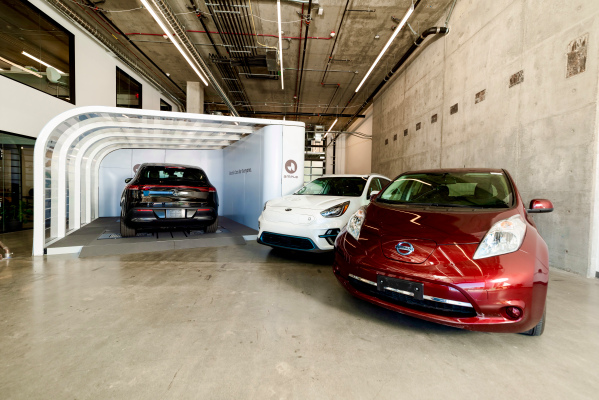
EV battery swapping itc Ample has locked back in two partnerships this month that will aid fuel an expansion through Japan and New York City when you finish years of working on the service. The startup, which was built in 2014 and came out of stealth in March, explained Tuesday it has partnered at Japanese oil and energy company Eneos to mutually deploy and operate it swapping infrastructure in Japan.
Over the next season, the two companies will pilot Ample’s fully automated replacing technology with a focus on ride-hailing, taxi, municipal, rental but also last-mile delivery companies. Plentiful and Eneos will also analyse whether swapping stations can provide other uses, such as a copying source of power for the power use grid. It is still birth for the partnership and couple of the details have been disclosed; Bouffant, for instance didn’t share the actual pilot program would embark on or where in Okazaki , japan it would initially launch. But even with these scant truth, Eneos’ interest signals because battery swapping — any minimum of for Ample — is regarded as gaining some believers.
Its Eneos announcement comes two or three days after Ample launched a part partnership with Sally, a New York City-based EV rental company for ride-hailing, taxi and last-mile deliveries. Ample and Sally will roll out five in order to really 10 stations in THE CITY by the fourth quarter of this particular year, with plans in which to expand into other currency market in 2021, according to Khaled Hassounah, founder and CHIEF EXECUTIVE OFFICER of Ample .
Ample’s partnership with Sally will additionally expand to San Francisco in the next couple of months. Depending on the cost of utilising both services, this might wind up being an advantageous deal due to ride-hailing drivers in A bunch of states, at least, where the state especially decreed 90% of Uber and Lyft drivers must be in EVs by 2030 .
“The goal is to ultimately make swapping stations as ubiquitous as gas stations,” Hassounah told TechCrunch.
Ample came out of stealth this March with five operational stations in the Bay Area and a partnership with Uber that entails drivers renting vehicles directly from Ample that have been retrofitted with the startup’s battery technology.
“The Ample architecture is designed to be integrated into any modern electric vehicle,” Levi Tillemann, VP for policy and international outreach at Ample, told TechCrunch. “Unlike a standard electric vehicle, where you have a battery pack that is never meant to be removed from the car, with the Ample system, you replace the battery pack with an adapter plate that essentially shares the exact same dimensions as the OEM designed battery pack. That adapter plate is the architecture that allows for battery swap.”
Ample’s standardized battery modules work with every vehicle that has been configured to run on the Ample platform, says Tillemann. With Ample’s partnership with Sally, the company will begin stepping away from running its own fleet, which it essentially launched to prove its business model. The company will work with Sally and probably other fleet and rental companies in the future to make vehicles Ample-enabled.
“Ample’s battery swapping works with any electric vehicle and dramatically reduces the cost and time it takes to install EV infrastructure by being a drop-in replacement for the OEM battery and does not require any modification to the car (either hardware or software),” said Hassounah.
One of the concerns that puts ride-hailing drivers off switching to EVs is the amount of time it takes to charge a battery. Hassounah says swapping a battery only takes 10 minutes, but that the company aims to reduce that to five minutes by the end of the year. Having a more efficient and seamless process might help ride-hailing drivers and logistics companies make the switch.
“Currently, drivers pay 10 cents per mile for swapping services, including energy, and the range varies based on the car model and battery size,” said Hassounah. “The price of the service varies depending on the price of electricity, but our goal is to have it be 10% to 20% cheaper than gas.”
When drivers want to swap a battery, they’ll use Ample’s app to find nearby stations and then initiate the autonomous swap. Each station can serve about five to six cars per hour, but the company expects to be able to serve double that by the end of the year. That said, this also depends on the amount of available power at a given site.
Tillemann says as Ample expands, the company aims to one day work with existing OEM partners to offer consumers the choice of having Ample production plates installed into their new vehicles on the production line.
“Our unit costs are very favorable for the battery swap systems,” he said. “They do not cost a lot to deploy, and that means, with a relatively low number of vehicles our battery swap architecture is economical and profitable.”
Eneos, which previously invested in Ample, according to the company, is committed to providing the next generation of energy supply. The company is < a href="https://techcrunch.com/2021/05/10/toyota-partners-with-eneos-to-explore-a-hydrogen-powered-woven-city/"> also exploring hydrogen not to mention recently partnered with Toyota’s Woven City , a futuristic essence city that’s being made in Japan, to power generally the metropolis using hydrogen.






